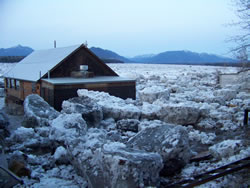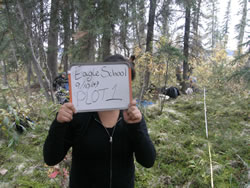
National Fire Plan Success Story
Eagle Community School: Annual Ecology Education Program
Yukon-Charley Rivers National Preserve, Alaska
National Fire Plan - Community Assistance
2009

Ice surrounds the flooded café in Eagle, Alaska. NPS photo by Carl Stapler.

Students establish flood effects plots near Eagle.
In 2009, the Alaska (AK) National Park Service (NPS) Fire Ecology Program conducted the 5th year of a field-based education program for the Eagle Community School in Eagle, Alaska. The program was established in 2004 when the town was threatened by wildfire. Annually since then, fire staff has led a group of students to visit fire effects plots close to the community in order to track forest succession after fire. The program demonstrates that natural events like fire and flood change the environment and that change is not necessarily negative.
In May 2009, Eagle, located on the banks of the Yukon River, was inundated by a rare and nearly devastating spring flood. The approximately 100 residents were severely impacted. AK NPS Fire Management Program personnel responded to the flood and provided assistance. After the incident, the fire ecology program incorporated post-flood forest recovery monitoring into the annual education program. In September 2009, the 7th through 12th grade class of thirteen students with their instructor Marlys House, joined Yukon-Charley Rivers NP Interpretive Park Ranger and the Regional Fire Ecologist to establish and gather data from four new flood effects plots on nearby Belle Island. Prior to the field trip, NPS staff gave a classroom presentation about the flood and led a discussion about the importance of emergency preparedness. Additionally, the students watched aerial video footage taken during the flood. Fire staff intends to alternate the annual field trips between revisiting the fire and flood-effects plots. The program continues to receive a warm reception from the Eagle community as a fun and informative way for students to become more familiar with the surrounding ecosystem.
Contact: Jennifer Mitchell, Regional Fire Ecologist, (907) 455-0656.